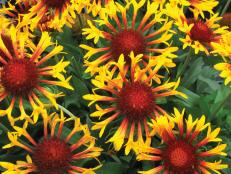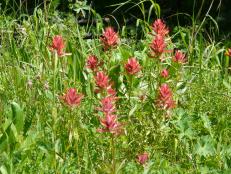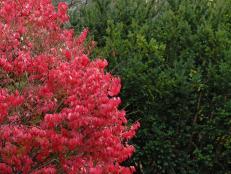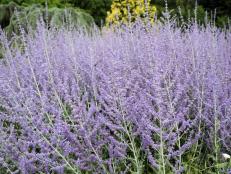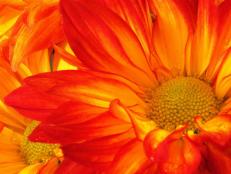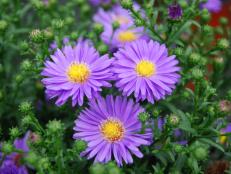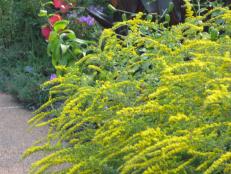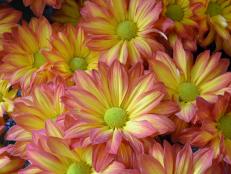20 Fall Wildflowers You'll Love
As summer bows out, fall wildflowers take center stage in brilliant colors like purple, yellow and orange. Black-eyed Susans, coneflowers and other autumn flowers are the stars of gardens, roadsides and meadows.

Even when summer blooms disappear, the flower show isn’t over. Fall wildflowers take their place, popping up on roadsides and in forests, fields and gardens. If you're not already growing them, planting wildflower seeds in fall will pay off in beautiful blooms next year. For best results, plant native autumn wildflowers or a wildflower seed mix blended for your region. Browse our gallery of fall wildflowers to find your favorites, and visit the Lady Bird Johnson Wildflower Center at the University of Texas at Austin for more inspiration about planting wildflowers in fall.
You may need to cold stratify or cold-moist stratify your seeds before planting wildflowers in fall. This helps seeds germinate and increases the rate of germination by mimicking the cold or cold-moist conditions they'd experience in nature. To cold-stratify, collect and air-dry the seeds, seal them in a plastic bag or container and refrigerate them for planting outside after the last spring frost. The length of storage time in the fridge depends on what you're growing, so check your seed packet, read our tips or do a little research.
To cold-moist stratify, put the seeds in damp paper towels or some moistened peat, vermiculite or sand in a sealed plastic bag or container. Refrigerate them for the recommended length of time and plant them outdoors after all danger of frost has passed. Periodically check your fall wildflower seeds for excess moisture.
Black-Eyed Susan

Steven Schwartzman/Lady Bird Johnson Wildflower Center
From summer to fall, black-eyed Susans (Rudbeckia hirta) bear golden-yellow daisy-like blooms studded with dark eyes. Native to eastern North America, most of these wildflowers grow 1 to 3 feet tall, but some varieties have been bred for growing in containers. Give them fertile soil, regular water and full sun (they’ll take partial sun, but won’t flower as much). Black-eyed Susans will drop seeds, and the easiest way to grow them is to cover them with 1/8-inch of soil. They'll overwinter and sprout in the spring. Ashleigh Smith, managing editor at True Leaf Market, an organic seed and horticultural company, says these short-lived perennials are often grown as annuals in USDA Gardening Zones 3 to 7.
Learn More: How to Grow and Care for black-eyed Susan
Blanket Flower

Lynn Coulter
Blanket flower (Gaillardia) is another daisy-like fall wildflower. Easy to grow, the plants reach 2 to 3 feet tall and slowly form mounds that blanket the ground in shades of orange, yellow and red. They aren't choosy about pH, prefer full sun and actually need poor soil on the slightly acidic side, as long as it drains well. They bloom from summer to fall and re-seed nicely, although new plants may look a little different from the parents if you grow hybrids. Deadhead or cut them often to encourage more blooms. Sow the seeds in late summer and give young plants some winter protection. These short-lived perennials, hardy in Zones 3 to 10, take a year to bloom when grown from seeds and usually live for two or three years.
Learn More: How to Grow Blanket Flower
Cardinal Flower

Alan Cressler/Lady Bird Johnson Wildflower Center
Thanks to its brilliant scarlet blooms, Lobelia cardinalis stands out near woodlands, marshes and streams. Watch for these fall wildflowers to appear from late spring into September or October. The showy plants attract hummingbirds and butterflies as they can grow to 6 feet tall and send up flower spikes. Cardinal flowers need humus-rich, moist-to-wet soil and sun to partial shade or shade; they can't tolerate drought. Collect the seeds when the capsules start to open and cold-moist stratify them for two months. Cardinal flowers are short-lived perennials in Zones 3 to 9. Although they die after blooming, they form offsets that can keep growing. Learn More: How to Grow Cardinal Flower
Coneflower

American Meadows
Echinacea purpurea, or purple coneflower, is a lovely perennial with long-lasting pinkish-purple flowers and raised, purple-brown centers. The plants bloom into September and need average, well-drained soil in sun to part shade. Butterflies flock to them and birds will eat the seeds if you let some flowers dry on the plants. Sow the seeds outdoors after the last frost. More may germinate if they're first cold-stratified for eight to 12 weeks, but some experts say that's not necessary. Native coneflowers can be purple, yellow or pink-purple, while hybridized coneflowers come in white, pink, yellow, orange, green and red. They're hardy in Zones 3 to 9.
Learn More: How to Grow Coneflower
Cosmos

Hadley Mueller/American Meadows
Cosmos are easy to grow from seed and bloom from early summer until frost. They can be annuals or perennials, but most gardeners grow the annual types, C. sulphureus, which are yellow, red or orange, or C. bipinnatus, which can be white or shades of pink. Depending on the species, cosmos plants top out at 1 to 7 feet tall. Give these undemanding fall wildflowers full sun and moderate water but not much compost or fertilizer, which produces weak stems with few flowers. They don't need much water, either, once they're established. Direct sow the seeds outdoors after your last spring frost or let them self-sow in the fall for flowers the following year.
Learn More: How to Grow Cosmos Flowers
Gentian

Alan Cressler/Lady Bird Johnson Wildflower Center
This Gentiana saponaria adds blue to the garden, a color that's often hard to find in nature. Other gentians flower in shades of violet, blue, white, yellow, red or purple. Also called harvestbells or soapwort gentian, G. saponaria is a perennial in Zones 5 to 9, while other species are hardy in Zones 3 to 7. Gentians can grow 1 to 3 feet tall with clusters of tubular flowers that don't fully open when they appear from late summer until about November. If you're planting wildflowers in fall, give gentians cool, partial shade (morning sun and afternoon shade are best) and easily draining, loamy soil. Once established, they need only moderate watering. They're slow and difficult to grow from seeds, so for best results, plant starts from nurseries that sell native plants.
Goldenrod

Wynn Anderson/Lady Bird Johnson Wildflower Center
Poor goldenrod (Solidago spp.). These yellow fall wildflowers have a bad rep. Allergy sufferers blame them for making them sneeze, but ragweed, which flowers around the same time, may be the real culprit. Like most wildflowers, goldenrod is easy to grow from seed and can be planted in spring or fall in a sunny spot that has average, well-draining soil. It doesn't need fertilizer. Once the plants mature, water them only during periods of drought. Most species are hardy in Zones 2 to 8; they vary in size and in how aggressively they spread.
Jewelweed
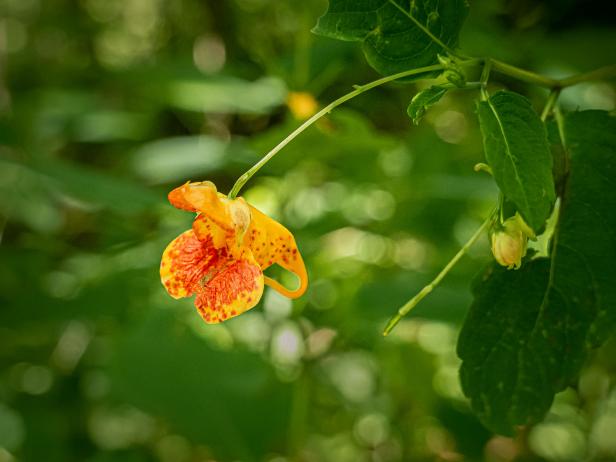
Stephanie Brundage/Lady Bird Johnson Wildflower Center
Call it jewelweed, spotted touch-me-not, orange balsam or its Latin name, Impatiens capensis. These fall-blooming wildflowers are annuals that bloom from late summer until frost. They thrive in part to full shade in humus-rich, moist or boggy soils; in the wild, you'll find them near streams, marshes and lakes. By mid-summer, jewelweed reaches two to five feet tall and its blue-green leaves almost sparkle — like jewels — when they catch drops of rain or dew. If you prefer yellow fall wildflowers, look for a less common species, I. pallida, which has reddish spots. The plant's touch-me-not nickname comes from its coiled seed capsules, which eject the ripened seeds when they’re touched. When you’re planting wildflower seeds in the fall, catch them in a bag and immediately plant them 1/4-inch deep or cold-stratify them for two to three months for planting after the last spring frost.
Joe Pye Weed

Ball Horticultural Company
At 5 to 7 feet tall, Joe Pye weed (Eutrochium purpureum) forms clumps of fragrant fall wildflowers. The tiny, tube-shaped flowers open from summer into early fall in pinkish-purple or mauve; some species have white, dark purple, light purple or pink flowers. Hardy in Zones 4 to 9, the plants need full to partial sun and relatively rich, moist soil that drains easily. Always keep them well-watered. Sow the seeds outdoors in the fall or cold-stratify the seeds for 30 days. Sow them indoors eight weeks before the last expected spring frost or outdoors after the last frost. Pictured here: Euphoria 'Ruby'.
Learn More: How to Grow Joe Pye Weed
Liatris

Ball Horticultural Company
Also known as Gayfeather or Blazing Star, Liatris spicata is a perennial with showy white, purple or rosy-purple flower spikes. The plants, which are hardy in Zones 3 to 9, can top out at 6 feet tall and flower into late fall. Give them well-draining, average soil and full sun, and they'll attract butterflies, birds and bees. Scarify the seeds (that is, nick them lightly with a knife) and direct-sow them in the fall. If you'd rather plant in the spring, cold-stratify the seeds for six to eight weeks and start them indoors six to eight weeks for planting after the last spring frost. They can take four weeks or more to germinate and two or more years to bloom, so plant nursery starts or corms for faster results. 'Kobold' is shown here.
Milkweed

Mary Walters/Walters Gardens
Common milkweed (Asclepiadaceae syriaca) is another of the fall wildflowers once used to treat various illnesses (again, never use a plant for medicinal purposes without first consulting a health professional). This tall perennial bears clusters of small, rosy-purple to pink flowers that butterflies and some 450 insects love to visit. It can look weedy as it grows 5 or 6 feet tall, so be careful where you put it; it spreads easily from rhizomes and seeds. Give milkweed full sun, plenty of space and moderately acidic, well-draining soil. Water until the plants are established. Like goldenrod, milkweed is one of the fall wildflowers blamed for allergies, and it can cause rashes in people allergic to latex. Don't get the sap in your eyes, and wash your hands after touching milkweed. Plant the seeds outside in late fall or cold-stratify them for three to six weeks before planting them outside when the soil warms up in spring. This milkweed is Asclepias incarnata 'Cinderella.'
Learn More: Growing Milkweed
New England Aster

W.D. and Dolphia Bransford/Lady Bird Johnson Wildflower Center
While you can buy a pink variety of New England asters, in nature these fall wildflowers (Symphyotrichum novae-angliae) bear showy, rose-purple blooms with orange-yellow eyes. Some New England asters have lavender, blue or white flowers. These perennials grow to 6 feet tall and bloom from August to November. They thrive in part shade and moist, acidic soil and provide nectar for bees, Monarchs and other butterflies. Sow the seeds outside in the fall or cold-moist stratify them for a month for planting outdoors after all danger of frost has passed.
Phlox

Hadley Mueller/American Meadows
There are over 60 phlox species. Phlox paniculata, also called garden or fall phlox, is a perennial wildflower that grows 2 to 4 feet tall with clusters of purple, pink or occasionally white flowers. Hardy in Zones 4 to 8, it blooms from midsummer into September or October. Give the plants full sun, although most are native to woodlands and can take filtered sun or light shade. They prefer moist, well-draining, organically rich soil. Phlox cultivars come in many colors; some are annuals and some are perennials. They vary in hardiness from Zone 3 to 9 or Zone 4 to 9.
Learn More: Growing Garden Phlox
Queen Anne's Lace

Image courtesy of Preen
Often seen in fields and roadside ditches, Daucus carota, Queen Anne's Lace, is also known as wild carrot. This biennial can grow to 4 feet tall, flowers in its second year and then dies. Its hundreds of tiny, white flowers are held in flattened clusters with dark centers. When its seeds ripen, the flowers curl inward in the shape of a bird's nest, which makes them easy to collect. Queen Anne's Lace is considered invasive in some areas, so check with your local extension service before you plant. It adapts to most well-draining soils and takes sun to partial shade, needing little care beyond watering during times of drought. Some people eat the long, carrot-like taproots, but this isn't recommended. The plants resemble poison hemlock (Conium maculatum), which is deadly to people, livestock and pets, even in small amounts.
Sneezeweed

April Moore/Lady Bird Johnson Wildflower Center
Another of the daisy-like, fall wildflowers, sneezeweed (Helenium autumnale) attracts bees and butterflies to its yellow blooms, which open from late summer into fall. Give this perennial, which is hardy in Zones 3 to 9, average to rich soil that stays moist and drains well. Sneezeweed thrives in full sun and can be staked or cut back in early summer if it gets too tall (it can reach 5 feet or more). The dried, crushed leaves and flowers were once used to make a snuff that caused sneezing, believed to expel evil spirits or clear stuffy noses. But all parts of the plants are poisonous to people, pets and livestock if ingested and can cause skin rashes. Plant the seeds in spring after the last frost or in the garden under a 6-inch layer of mulch after the first fall frost. After all danger of frost has passed, remove the mulch. Sneezeweed varieties are available with gold, red, copper brown and orange blooms.
Stokes Aster

Cassidy Garcia Photography
Plant Stokesia laevis, Stokes' Aster, for rosettes of pretty lavender to bluish flowers that open from late spring into September. These perennials grow to 1 to 2 feet tall and will only re-bloom if you remove the flowers before they form seeds. Look for these autumn wildflowers in white, purple and blue and give them sun to part shade and moist, rich, well-drained soil. They prefer soils enriched with compost or organic matter. Although they're heat tolerant, they need medium to high amounts of water and can't take drought. Hardy in Zones 5 to 9, they're great in borders or as groundcovers. Studies have shown that Stokes' Aster seeds don't seem to need cold-stratification. Sow them outdoors after the last spring frost or indoors four to six weeks before the last frost.
Sunflower

Lee Page/Lady Bird Johnson Wildflower Center
Helianthus annuus, the common sunflower, is grown for its seeds, which can be eaten or made into cooking oil. It's also an attractive ornamental that carries lots of flowerheads on its many branches; domestic sunflowers usually have one bloom per stem. These heat-tolerant beauties are great for cutting. Some top out around 16 feet tall, while others have been bred short enough for containers. As their name suggests, sunflowers love sun. They also need loose, well-draining soil that's slightly acidic to slightly alkaline. Give them plenty of organic matter, compost or a slow-release granular fertilizer. Smith recommends sowing the seeds after the last frost in a prepared garden spot, since they dislike transplanting. Perennial sunflowers bloom in Zones 3 to 10 from August until frost, she adds, and look best in the back of beds.
Learn More: How to Grow Sunflowers
Tickseed Sunflower

Lynn Coulter
Also known as swamp marigolds and bearded beggarticks, tickseed sunflowers (Bidens aristosa) carpet fields and meadows from mid to late summer into October. These fall wildflowers are related to coreopsis and have yellow to orange daisy-like blooms. Their prickly seeds, called beggar's ticks, tend to stick to animal fur or your clothes and shoes when you walk by. Tickseed sunflowers grow best in full sun and nutrient-rich, well-draining soil. They'll tolerate partial shade but won't flower as freely. In Zones 8 to 11, the plants will drop their ripened seeds and naturalize. In cooler regions, treat them like annuals and replant after the last spring frost. There are native varieties of Bidens with red, orange, white, yellow and pink flowers suitable for various hardiness zones.
Turtlehead
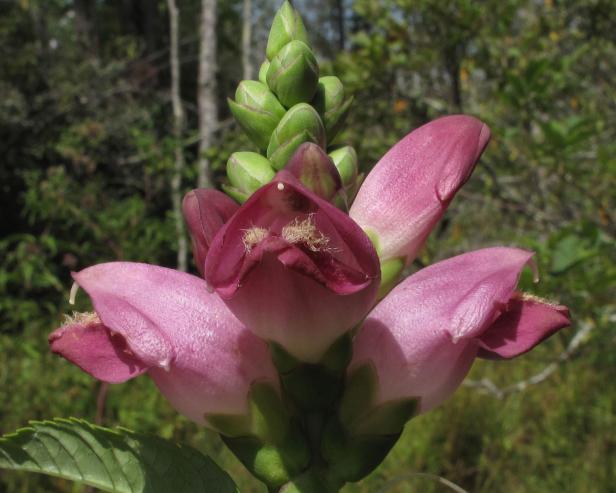
Alan Cressler/Lady Bird Johnson Wildflower Center
Chelone spp. are nicknamed for their flowers, which look like turtle's heads and open from late summer to fall. This densely clumping perennial, which is hardy in Zones 3 to 9, grows slowly and needs organically rich, consistently moist soil and filtered sun to partial sun. Depending on the species, hybrid, or cultivar, turtlehead flowers can be purple, white, deep rose-pink or almost red. Most grow 2 to 3 feet tall. Start turtleheads from nursery plants or seeds, indoors or outdoors, in the spring. Some turtlehead seeds need stratification, so follow the directions on your seed packet.
Yarrow
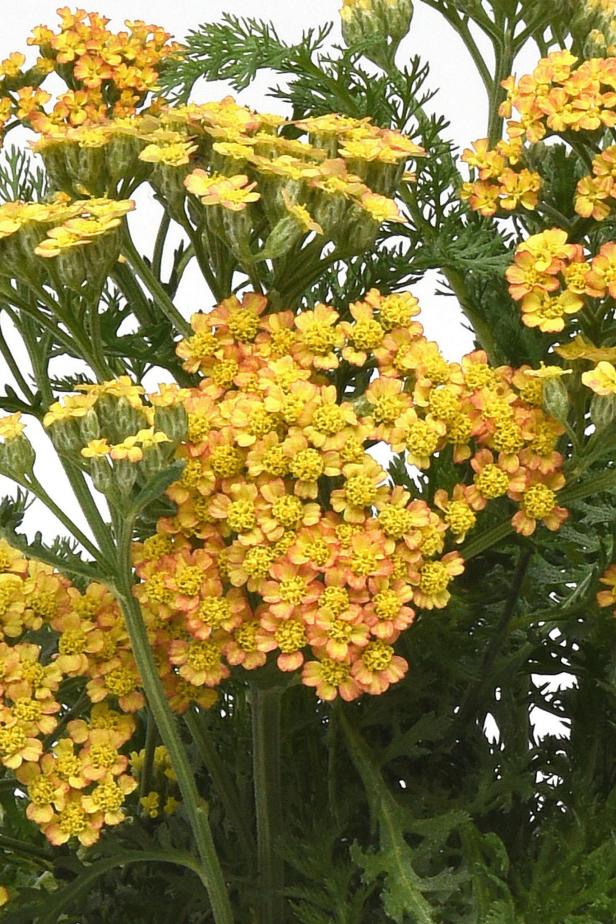
Ball Horticultural Company
Some people use yarrow for medicinal purposes but do not do this without first consulting a healthcare professional. Achillea millefolium, common yarrow, is a perennial herb in Zones 3 to 10. It blooms in June and reblooms into September or October if it's cut back, says Smith. Common yarrow has flat or domed-shaped clusters of tiny, white flowers, while cultivated varieties have yellow-gold, pink or red flowers. Give yarrow full sun and well-drained, loamy soil; it will grow in clay soil that's not too wet. Most yarrows reach 2 to 4 feet tall. A. millefolium is aggressive, so know what you're buying before you plant. Direct sow the seeds outdoors after the last spring frost, Smith says, and cover them very lightly, as light helps them germinate. You can also start the seeds indoors eight to 10 weeks before the last spring frost. This yarrow is 'Milly Rock Yellow.'
Learn More: Growing Yarrow

.-Battle-on-the-Beach-courtesy-of-HGTV.-.jpg.rend.hgtvcom.196.196.suffix/1714761529029.jpeg)




